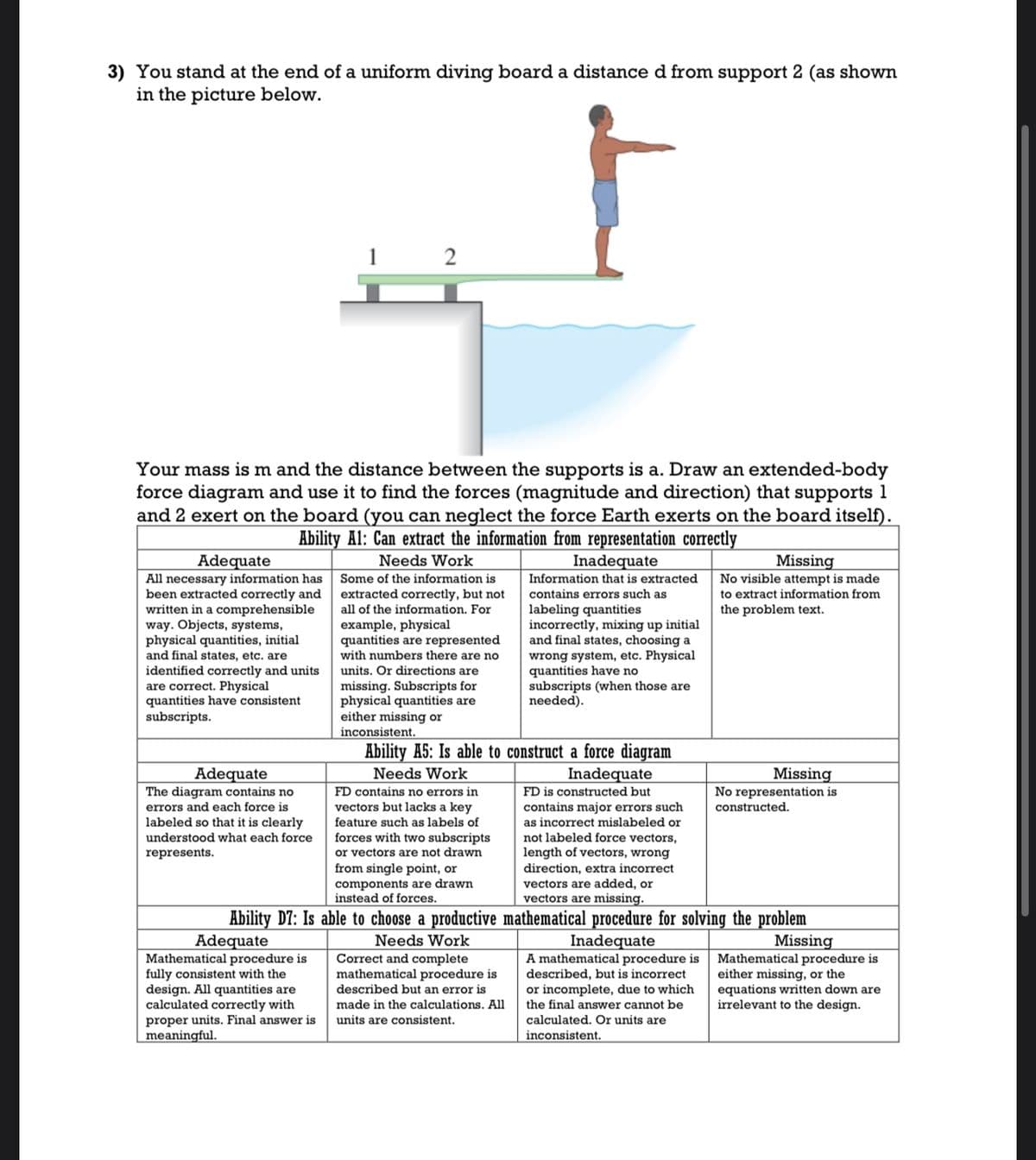3) You stand at the end of a uniform diving board a distance d from support 2 (as shown in the picture below. Your mass is m and the distance between the supports is a. Draw an extended-body force diagram and use it to find the forces (magnitude and direction) that supports 1 and 2 exert on the board (you can neglect the force Earth exerts on the board itself).
3) You stand at the end of a uniform diving board a distance d from support 2 (as shown in the picture below. Your mass is m and the distance between the supports is a. Draw an extended-body force diagram and use it to find the forces (magnitude and direction) that supports 1 and 2 exert on the board (you can neglect the force Earth exerts on the board itself).
College Physics
1st Edition
ISBN:9781938168000
Author:Paul Peter Urone, Roger Hinrichs
Publisher:Paul Peter Urone, Roger Hinrichs
Chapter9: Statics And Torque
Section: Chapter Questions
Problem 10CQ: Suppose you pull a nail at a constant rate using a mall puller as shown in Figure 9.23. Is the nail...
Related questions
Question

Transcribed Image Text:3) You stand at the end of a uniform diving board a distance d from support 2 (as shown
in the picture below.
Your mass is m and the distance between the supports is a. Draw an extended-body
force diagram and use it to find the forces (magnitude and direction) that supports 1
and 2 exert on the board (you can neglect the force Earth exerts on the board itself).
Ability A1: Can extract the information from representation correctly
Needs Work
Some of the information is
extracted correctly, but not
all of the information. For
example, physical
quantities are represented
with numbers there are no
units. Or directions are
missing. Subscripts for
physical quantities are
either missing or
inconsistent.
Adequate
All necessary information has
been extracted correctly and
written in a comprehensible
way. Objects, systems,
physical quantities, initial
and final states, etc. are
identified correctly and units
are correct. Physical
quantities have consistent
subscripts.
Adequate
The diagram contains no
errors and each force is
labeled so that it is clearly
understood what each force
represents.
1 2
Adequate
Mathematical procedure is
fully consistent with the
design. All quantities are
calculated correctly with
proper units. Final answer is
meaningful.
Inadequate
Information that is extracted
contains errors such as
labeling quantities
incorrectly, mixing up initial
and final states, choosing a
wrong system, etc. Physical
quantities have no
subscripts (when those are
needed).
Ability A5: Is able to construct a force diagram
Needs Work
Inadequate
Missing
No visible attempt is made
to extract information from
the problem text.
FD contains no errors in
vectors but lacks a key
feature such as labels of
forces with two subscripts
or vectors are not drawn
from single point, or
components are drawn
instead of forces.
FD is constructed but
contains major errors such
as incorrect mislabeled or
not labeled force vectors,
length of vectors, wrong
direction, extra incorrect
vectors are added, or
vectors are missing.
Ability D7: Is able to choose a productive mathematical procedure for solving the problem
Inadequate
Needs Work
Correct and complete
mathematical procedure is
described but an error is
made in the calculations. All
units are consistent.
A mathematical procedure is
described, but is incorrect
or incomplete, due to which
the final answer cannot be
calculated. Or units are
inconsistent.
Missing
No representation is
constructed.
Missing
Mathematical procedure is
either missing, or the
equations written down are
irrelevant to the design.
Expert Solution
This question has been solved!
Explore an expertly crafted, step-by-step solution for a thorough understanding of key concepts.
This is a popular solution!
Trending now
This is a popular solution!
Step by step
Solved in 2 steps with 2 images

Knowledge Booster
Learn more about
Need a deep-dive on the concept behind this application? Look no further. Learn more about this topic, physics and related others by exploring similar questions and additional content below.Recommended textbooks for you

College Physics
Physics
ISBN:
9781938168000
Author:
Paul Peter Urone, Roger Hinrichs
Publisher:
OpenStax College

Principles of Physics: A Calculus-Based Text
Physics
ISBN:
9781133104261
Author:
Raymond A. Serway, John W. Jewett
Publisher:
Cengage Learning

University Physics Volume 1
Physics
ISBN:
9781938168277
Author:
William Moebs, Samuel J. Ling, Jeff Sanny
Publisher:
OpenStax - Rice University

College Physics
Physics
ISBN:
9781938168000
Author:
Paul Peter Urone, Roger Hinrichs
Publisher:
OpenStax College

Principles of Physics: A Calculus-Based Text
Physics
ISBN:
9781133104261
Author:
Raymond A. Serway, John W. Jewett
Publisher:
Cengage Learning

University Physics Volume 1
Physics
ISBN:
9781938168277
Author:
William Moebs, Samuel J. Ling, Jeff Sanny
Publisher:
OpenStax - Rice University

Glencoe Physics: Principles and Problems, Student…
Physics
ISBN:
9780078807213
Author:
Paul W. Zitzewitz
Publisher:
Glencoe/McGraw-Hill

An Introduction to Physical Science
Physics
ISBN:
9781305079137
Author:
James Shipman, Jerry D. Wilson, Charles A. Higgins, Omar Torres
Publisher:
Cengage Learning